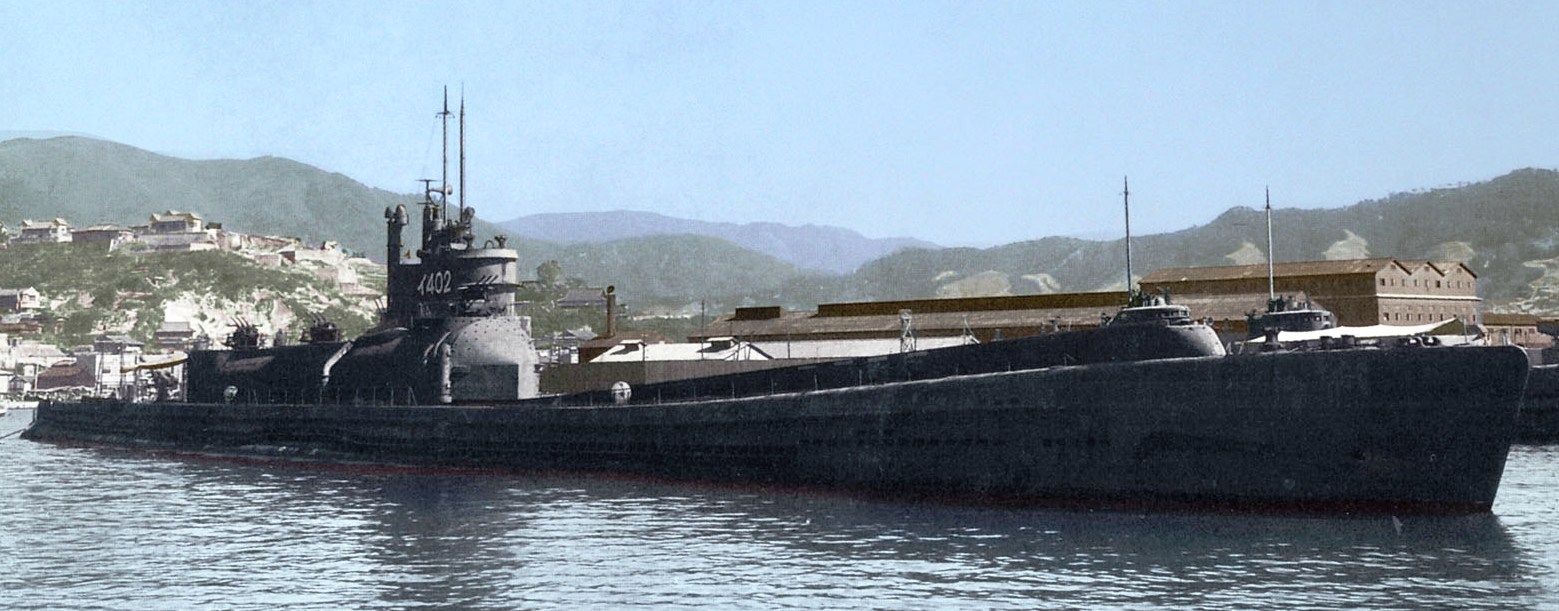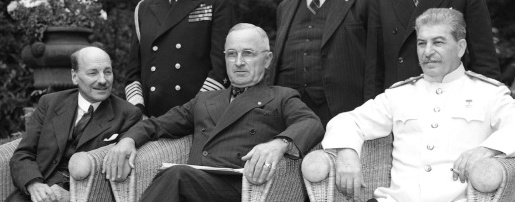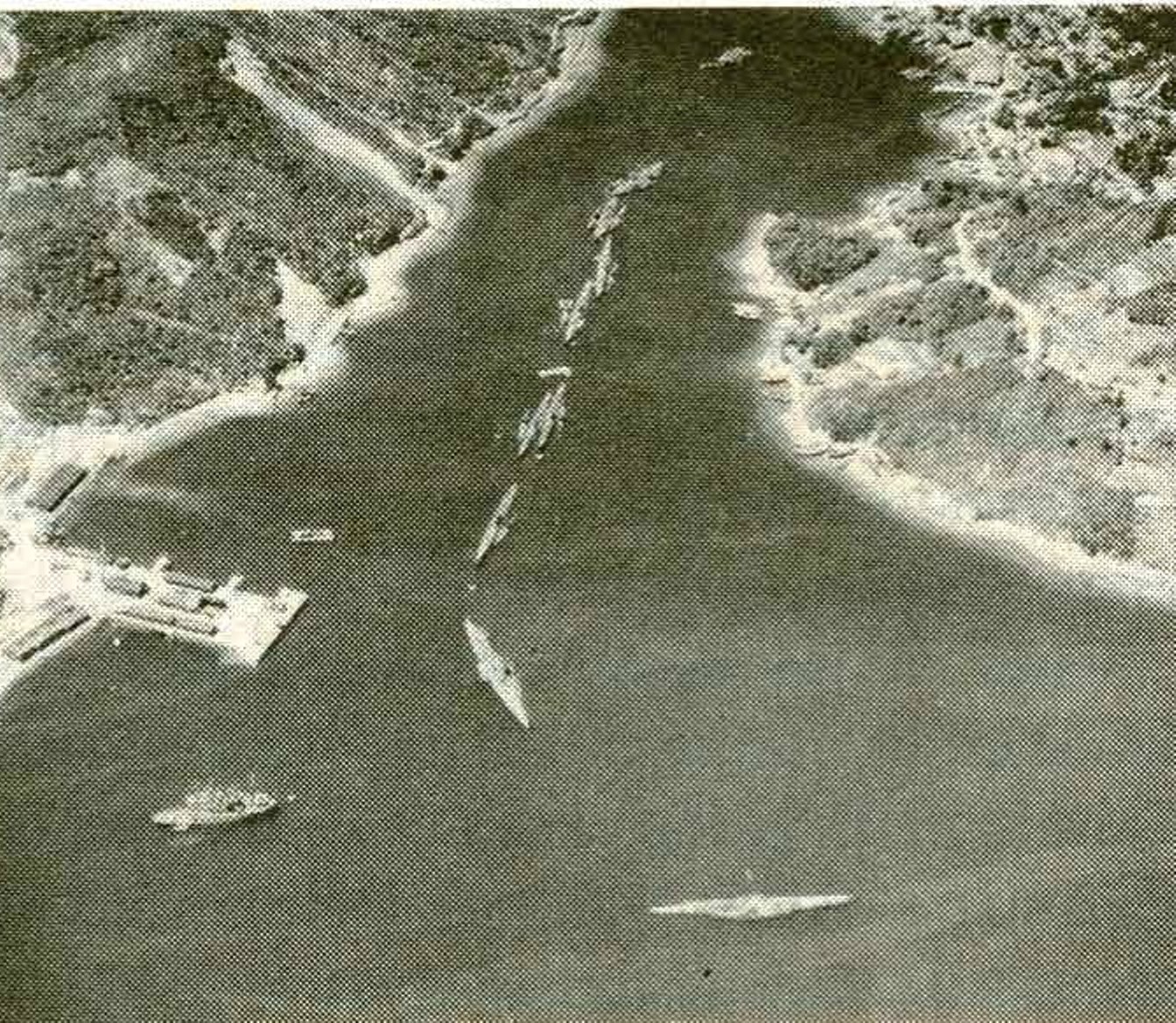© 2011 Bob Hackett
Rev 1
 The Final Destruction of Japan’s Submarine Fleet
The Final Destruction of Japan’s Submarine Fleet
 (I-402 colorized photo by Irootoko Jr)
(I-402 colorized photo by Irootoko Jr)
By Bob Hackett and Derek Waller

26 July 1945:
Potsdam, Germany. The United States, United Kingdom and
the Republic of China in the Potsdam Proclamation, announce their proposed
terms for Japan's surrender, which include a statement that "The Japanese
military forces shall be completely disarmed." At that time, the Russsians are
not at war with Japan.
 (Atlee, Truman and Stalin at Potsdam, 1945)
(Atlee, Truman and Stalin at Potsdam, 1945)
2 August 1945:
The Americans, British and Russians sign the Potsdam
Agreement. Among other things, the Agreement seals the fate of the majority of
Germany’s surrendered Kriegsmarine’s U-Boats. Each of the three major Allies is
allowed to retain 10 U-Boats for testing and experimental purposes. The
remaining 118 U-Boats on either side of the Atlantic are to be sunk in deep
water before 15 February 1946.
6 September 1945:
Washington DC. President Harry S. Truman approves a
document “United States Initial Post-Defeat Policy Relating to Japan” which
includes statements that “Japan's ground, air and naval forces shall be
disarmed and disbanded and that “naval vessels …shall be surrendered and shall
be disposed of as required by the Supreme Commander” (SCAP - General of the
Army Douglas MacArthur).
At the end of the war, 49 former Imperial Japanese Navy (IJN) submarines
surrender afloat in the Far East. Many of these boats surrender at the IJN base
at Sasebo, near Nagasaki, in the far west of Kyushu. Three ex-German U-Boats
also surrender to US forces in Japan: U-511 at Maizuru and two ex-Italian
U-Boats, UIT-24 and UIT-25 at Kobe. [1]
Four other ex-U-Boats surrender under the Japanese flag to the Royal
Navy; two in Singapore and two in Java. The Potsdam Proclamation determined the
fate of these four ex-U-Boats, but it did not specify the fate of the three
ex-U-Boats in Japan.
October 1945:
Five IJN ‘super’ submarines (I-14, 1-201, I-203, I-400
and I-401) are moved from Japan to Pearl Harbor, Hawaii for test and evaluation
by the USN. These are to be destroyed at the discretion of the C-in-C Pacific
Fleet.
Late 1945:
Most remaining IJN submarines are moved from the ports
where they surrendered to Sasebo, especially those from Kure.
February 1946:
All four ex-U-Boats are sunk/scuttled in Singapore and
two in Java in accordance with the recommendations of the Tripartite Naval
Commission (TNC) set up following the Potsdam Declaration in Europe to dispose
of the remnants of the Nazi fleet:
3 February 1946:
I-505 (ex-U-219) is sunk south of Sunda Strait,
Indonesia by Royal Netherlands Navy destroyer Hr.Ms. KORTENAER (ex-British HMS
SCORPION).
15 February 1946:
Ex-U-boats, I-501 (ex-U-181) and I-502 (ex-U-862)
are sunk by Royal Navy frigates HMS LOCH LOMOND and HMS LOCH GLENDHU in the
Straits of Malacca, off Singapore, while I-506 (ex-U-195) is sunk by the Royal
Navy’s cruiser HMS SUSSEX in the Bali Sea, east of Kangean Island.
26 March 1946:
Washington DC. At a Submarine Officers’ Conference it
is reported that "orders are being issued to dispose of all Japanese submarines
by sinking. Those in Japan will be sunk at once, those in Pearl Harbor when
authorized by SCAP and at the discretion of CINCPAC". This statement included
all surviving Japanese submarines, including those which had been incomplete or
which had been decommissioned at the time of their capture, and those moved to
Pearl Harbor by the USN.
The decision also includes the three ex-U-Boats that surrendered in
Japan, but which had not been destroyed in accordance with the Potsdam
Agreement because the USN’s CNO successfully argues they were Japanese
submarines when surrendered and, therefore, outside the Agreement’s
jurisdiction.
April 1946:
Tokyo. SCAP approves a plan that calls for all former
Japanese Navy combatant ships larger than destroyer class to be completely
scrapped. It calls for wrecked and heavily damaged ships to be sunk in deep
water and to dispose of all submarines afloat.
There are five main disposal areas for the Japanese submarines to be sunk
at sea. These are Maizuru Bay, Kii Suido, Iyo Nada (The Inland Sea), off Sasebo
Bay, and at “Point Deep Six” off the island of Goto-Retto about 40 miles west
of Nagasaki.
 (Final Sortie from Sasebo)
(Final Sortie from Sasebo)
1 April 1946: “Operation “Road’s End”:
Twenty-four IJN submarines
capable of sailing under their own power and manned by skeleton Japanese crews
left Sasebo and were assembled at “Point Deep Six”. There, they are sunk near
the 100 fathom line, either by demolition charges or by gunfire from submarine
tender USS NEREUS (AS-17) and destroyer USS EVERETT F. LARSON (DD-830). [2]
 ("Roads End" subs underway)
("Roads End" subs underway)
5 April 1946: Operation “Dead Duck”:
Off Sasebo Bay. Four disabled
former IJN submarines are towed to sea and sunk by explosive charges. These are
I-202, HA-207, HA-210 and HA-216.
16 April 1946:
I-503 (former Italian COMANDANTE ALFREDO CAPPELLINI,
later German UIT-24) is sunk by the USN in the Kii Suido (Strait) between the
islands of Honshu and Shikolu. She had been captured in the Mitsubishi Shipyard
at Kobe, on the south coast of Honshu.
That same day, I-504 (former Italian LUIGI TORELLI, later German UIT-25
is also sunk by the USN in the Kii Suido. She had been captured in Kawasaki’s
Shipyard at Kobe.
30 April 1946:
RO-500 (ex-German U-511 is sunk by the USN in the Sea
of Japan in Wakasa Bay near Maizuru on the north coast of Honshu Island where
she had been surrendered. The exact circumstances of the three ex-U-boats final
disposal are unclear, although it seems probable that were towed to sea and
scuttled with demolition charges. IJN submarines I-121 and RO-68 are also
scuttled off Maizuru that same day.
 (I-121, RO-68 and RO-500's final day at Maizuru)
(I-121, RO-68 and RO-500's final day at Maizuru)
May 1946:
Only a few former IJN submarines are left afloat and these
are scuttled in the Iyo Nada (Inland Sea). They are I-155, RO-62, RO-63 and
HA-205. That same month, the last operations are conducted by the USN to
destroy the five IJN submarines that had undergone test and evaluation at Pearl
Harbor. All are sunk off Hawaii by United States submarines:
21 May 1946:
I-203 is sunk by USS CAIMAN (SS-323).
23 May 1946:
I-201 is sunk by USS USS QUEENFISH (SS-393).
28 May 1946:
I-14 is sunk by USS BUGARA (SS-331).
31 May 1946:
I-401 is sunk by USS CABEZON (SS-334).
4 June 1946:
Finally, I-400 sunk by USS TRUMPETFISH (SS-425). [3]
1946:
I-369 is scrapped at Yokosuka Navy Yard and HA-209 is scrapped
at Mitsubishi's Shipyard at Shimonoseki. HA-204, that grounded in Aburatsu Bay
in October 1945, is the last submarine to go. Her hulk is scrapped in 1948.
General MacArthur’s Report records that by October 1946 all submarines (a
total of 151) had been disposed of. The Report quotes a June 1949 in the Tokyo
“Pacific Stars and Stripes” newspaper article dated that when the IJN disposal
task was complete, “42 submarines had been scrapped and a further 104 had been
sunk”. Thus, in addition to the disposal of the 49 IJN submarines which
surrendered, some 100 other submarines were subject to the disposal process as
outlined in the Potsdam Protocol.
It has been possible to detail where and when the 49 former IJN
submarines shown above met their final end; but details are less precise
concerning the 100 or so other (unseaworthy) submarines captured in Japan at
the end of the war. Further, the Imperial Japanese Army (IJA) had operated a
number of transport submarines and seven of these were surrendered at the end
of the war.
Authors' Notes:
[1] The 49 IJN submarines that surrendered afloat were:
I-Class:
I-14, I-36, I-47, I-53, I-58, I-121, I-155, I-156, I-157,
I-158, I-159, I-162, I-201, I-202, I-203, I-363, I-366, I-367, I-369, I-400,
I-401, I-402, I-501 (U-181), I-502 (U-862), I-503 (UIT-24), I-504 (UIT-25),
I-505 (U-219) and I-506 (U-195)
RO-Class:
RO-50, RO-62, RO-63, RO-68 and
RO-500 (U-511)
HA-Class:
HA-103, HA-105, HA-106, HA-107, HA-108, HA-109,
HA-111, HA-201, HA-202, HA-203, HA-204, HA-205, HA-207, HA-208, HA-209 and
HA-210.
[2] The 24 IJN submarines sunk off Sasebo in Operation “Road’s End” were:
I-36, I-47, I-53, I-58, I-156, I-157, I-158, I-159, I-162, I-366, I-367,
I-402, RO-50, HA-103, HA-105, HA-106, HA-107, HA-108, HA-109, HA-111, HA-201,
HA-202, HA-203 and HA-208.
[3] Reportedly, I-400, I-401, I-14 and the I-200 class submarines were
sunk to prevent their technology from being surrendered to the Russians.
[4] In 2004, co-author Bob Hackett worked with Parallax Film productions
of Canada which produced "Sen Toku: The Search for Japan's Ghost Fleet" that
aired as a Discovery Channel special that year. This search located several of
the 24 former IJN submarines scuttled off Goto Retto in "Operation Road's End".
[5] On 17 March 2005, off Oahu, Hawaii, the Hawaii Undersea Research
Laboratory's (HURL) deep-diving submersibles Pisces IV and V located I-401 off the coast of Kalaeloa. I-401 lies in about 870
meters (2827 feet) off the coast of Barbers Point.
[6] On 15 February 2009, off Barber's Point, Hawaii, HURL’s deep-diving
submersibles Pisces IV and Pisces V located I-14 ; The wreck’s portions lies at a depth of about 800
meters. The next day, Pisces IV located I-201 nearby.
Co-author Derek Waller, Air Commodore, RAF (Ret), authored many fine
articles concerning the post war surrender and destruction of German U-boats
that are posted on the excellent uboat.net website.
Thanks go to Sander Kingsepp of Estonia for providing some Japanese
language source data.
-Bob Hackett and Derek Waller
Questions or comments should be posted on the board below:











